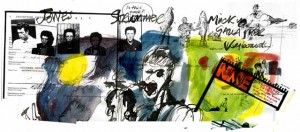1944 – October 14, 2008
Chris Salewicz remembers;
‘A rounded human being carrying his fair share of demons.’ That was Ray Lowry’s assessment of Clash frontman Joe Strummer. But Ray Lowry, England’s greatest rock’n’roll artist, might well have been looking in the mirror at his own image, even though – strengthened by his own unremitting sense of absurdity – in recent years he’d wrestled most of those demons to the ground.
About four years ago I called Ray up – it was a long time since I had spoken to him. ‘How are you, Ray?’ I asked.
‘I’m dying,’ he replied.
‘We all are,’ I said, trying to make a joke. But then he told me that he genuinely was ill, and that it would ultimately be fatal. His doctor had told him to quit drinking, he said, and he claimed that he almost had. I couldn’t avoid flashing back to the first time I met him, early in July 1978, when the Clash’s On Parole tour played in Manchester: I was writing an article about the group for the NME and Ray had been commissioned to illustrate the article, to my knowledge a first in rock’n’roll journalism. We connected in a pub somewhere in the city centre. Ray concealed his face behind the pint pot he held to his mouth, a very clear security blanket and a handy justification for ordering more drink – so that the shield could be kept in place. It made me realise immediately that he was painfully shy, which seemed to run hand-in-glove with the acute sensitivity and innocent wit of his images and observations. ‘All Ray’s characters were drawn in profile: almost as though he couldn’t look at anyone face on,’ said Neil Spencer, who became editor of the NME in 1978 and commissioned a regular three-frame strip from him.
He also asked Ray to go on those Clash on Parole dates. And Ray Lowry’s brief to sketch the Clash on that tour significantly moved on his career. Although he had already met the group when they had played at Manchester’s Electric Circus at the end of 1976, the time spent with them in 1978 cemented his relationship with the definitive punk act. On the group’s second tour of the United States in 1979, he accompanied the Clash: ‘war artist’ was how Strummer described him; as a consequence he designed the sleeve for the group’s next album, a pastiche of the cover of Elvis Presley’s first LP. A perfect package, London Calling is now considered one of the best albums of all time.
Born in Salford, raised by his widowed father, Ray Lowry went to a local grammar school. ‘Most of my friends and I showed little artistic or academic promise,’ he revealed, ‘but cared fanatically for the most arcane areas of the holy rock and roll thunder which had crashed down upon us out of nowhere.’ Ray even dressed like an old rocker, his US tour with the Clash allowing him to finesse his look through the nation’s myriad thrift-stores.
Leaving school Ray Lowry drifted through a succession of jobs in advertising agencies, first in Manchester, and then in London. Experimenting with abstract painting – which was always his true artistic love – he began to develop his own style. The cartoons followed on, and he found an outlet for them in the burgeoning underground press of the late 1960s, being published in Oz and International Times. Soon his work was appearing in Punch and Private Eye. In 1976 he began working for the NME, as well as occasionally reviewing records; after The Face was launched in 1980 by former NME editor Nick Logan, who had first hired Ray, he wrote a regular column for two years for the cutting-edge magazine. He also had time to have a son.
When Johnny Green, former Clash road manager, wrote his account of the group’s first years, A Riot of Our Own, Ray Lowry provided the illustrations. He was also the author of four collections of his own work – Only Rock and Roll, This Space to Let, Ray Lowry – Ink and The Clash, Up-Close and Personal, a DVD and book set.
Opening before he passed on and still running until November 7 is an exhibition of Ray’s work, at The See Gallery in Rawenstall in Lancashire. Included is a collection of colour images inspired by the 1960 British tour by the legendary American rock’n’roll stars Eddie Cochran and Gene Vincent, during which a car smash left Cochran dead and Vincent disfigured.
Ray was very happy about the exhibition. He told a friend it had given him ‘a new lease of life’.

Ray Lowry website here
